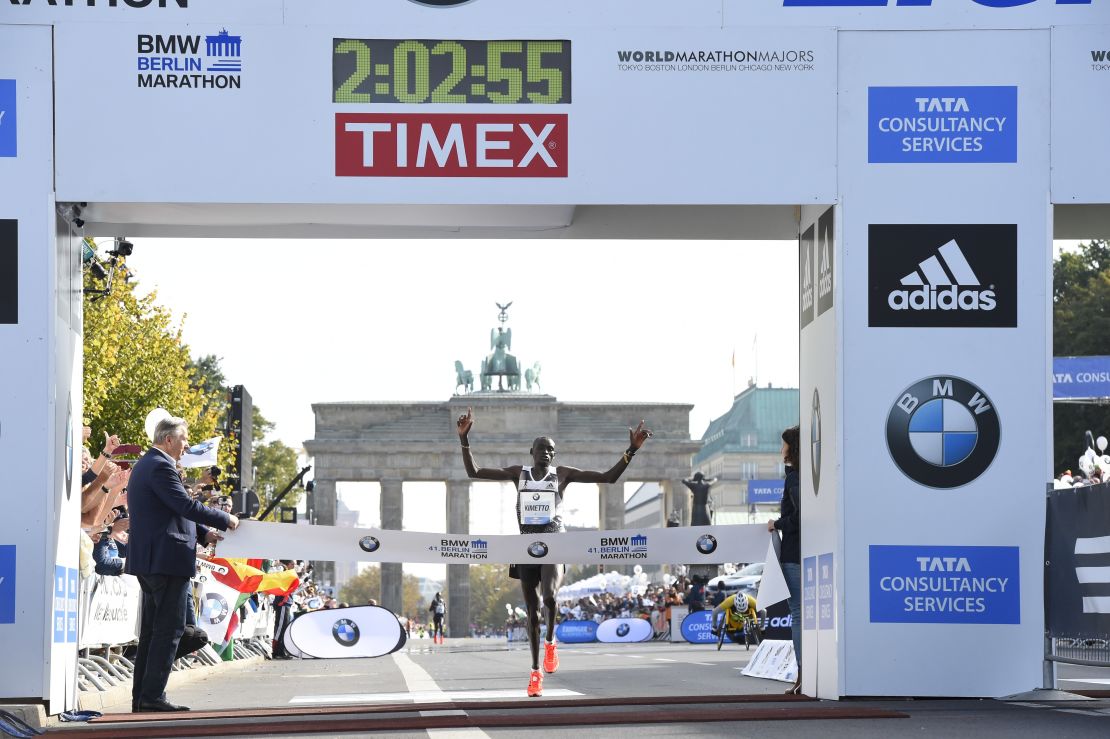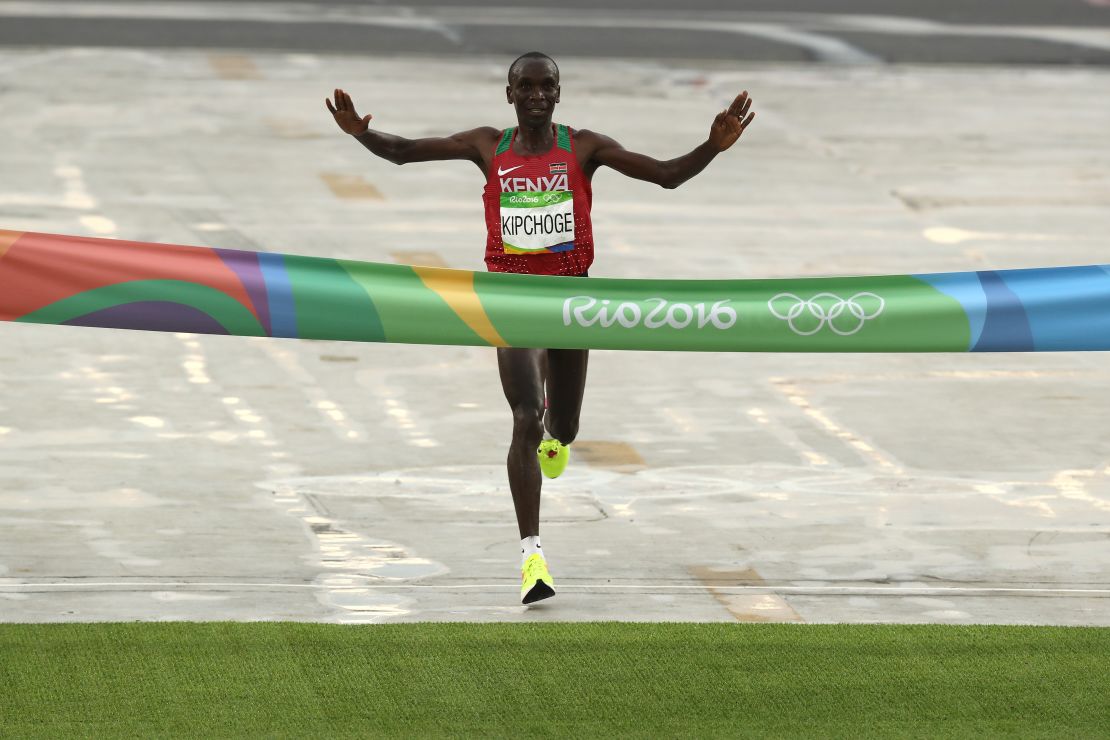Editor’s Note: On May 6, Eliud Kipchoge ran 2:00:25 for a marathon in Monza, Italy, as part of Nike’s “Breaking2” project. Although over two-and-half minutes faster than the current record, the conditions of the run mean that Kipchoge’s time may not count as a world record should Nike apply for official status.
Story highlights
Current marathon WR is 2:02:57
Nike has launched sub two-hour project
Official attempt scheduled for Saturday
The history of competitive running is measured out by milestones. Roger Bannister’s four-minute mile, Jim Hines’s 10-second 100m, and Paula Radcliffe’s unprecedented 2:15:25 marathon all redefined the barriers of human potential.
But now, 63 years to the day since Bannister’s historic run, a new horizon beckons.
Running a marathon under two hours is now one of the most coveted frontiers in athletics, and the desire to achieve it has never been greater.
In 2014, sportswear brand Nike launched a project – “Breaking2” – dedicated to achieving that goal. This weekend could see years of research, design and planning – all devoted to maximizing human potential over 26.2 miles (42.2km) – come to fruition.
At Monza racetrack in Italy on May 6, Nike, armed with three of the world’s best marathon runners, has scheduled its first official attempt to run a marathon in under two hours.
But it’s difficult to underestimate the enormity of the task.
A sub-two-hour marathon involves running at a pace of 4:34 per mile – seven seconds quicker than the current record of 2:02:57 set by Kenya’s Dennis Kimetto at the 2014 Berlin Marathon.
No one has knocked this much time off the men’s world record since the 1950s.
For those involved in the project, it’s more of a mental than a physical milestone; breaking the record could have huge ramifications for athletes worldwide.
“What it will mean to a running population is that it would be a big mental barrier where people can understand yes, we can do this,” Brad Wilkins, the director of NXT Generation Research in the Nike Sport Research Lab, told CNN.
“We believe that once a sub-two-hour marathon is done the records will fall at traditional marathons after that. People will run faster and faster, similar to when Roger Bannister broke the four-minute mile. Within a couple of months after he did that, it was broken three more times.
“So we’re expecting – we’re hoping – that a similar thing will happen. You get past that mental barrier of this two-hour mark and in traditional marathons it’s destined to fall.”
By tracking the trajectory of world record times, man should break the two-hour barrier by 2030. Nike, however, wants to do it Saturday. It’s a feat, if accomplished, that would send human athletic advancement hurtling into the future.
READ: Can a two-hour marathon be run?
READ: Jerusalem marathon builds bridges in a divided city
READ: 70-year-old woman runs 7 marathons on 7 continents in 7 days
READ: Marathon running linked to kidney injury
Who, what and where?
To deliver these results, the project intends to challenge the status quo behind marathon running. It’s a task that’s been made easier after securing the services of some of the world’s best long-distance runners.
In Eliud Kipchoge, the “Breaking2” project has the 2016 Olympic champion and the 2016 winner of the London marathon. The Kenyan is joined by Lelisa Desisa, two-time winner of the Boston marathon, and Zersanay Tadese, the current half-marathon world record holder.

Rather than coinciding the attempt with one of the big city marathons such as London, Berlin, New York, or Boston, the project has chosen to stage the attempt on Monza’s fixed 2.4km looped track – the location of the fastest lap in the history of Formula One.
It’s a deliberate decision intended to maximize human potential over the marathon distance.
“Monza’s very flat, no hills really,” said Wilkins.
“And that’s the best for speed. There’s very wide corners, no sharp turns. People have to slow down to go round the sharp turns, so having these wide sweeping turns allows you to optimize your energy for running very, very fast.
“We expect to have very cool temperatures. Monza’s very protected, there’s trees on one side, there’s stands so you don’t have many wind interactions on a day-to-day basis.”
At a recent time trial, Kipchoge ran a half-marathon at Monza in a time of 59:17, over 40 seconds quicker than the project’s intended pace.

Will it count as a record?
All marathon records need to be officially ratified by the IAAF, the international governing body for athletics.
In 2011, for example, Kenyan Geoffrey Mutai ran 2:03:02 at the Boston marathon, a time which wasn’t recognized as a record due to a tailwind and the drop in elevation between start and finish.
The IAAF told CNN that it would not be able to judge whether Nike’s attempt will count as an official time until it has taken place.
But David Bedford, a former British distance runner of the 1970s who held the 10,000-meter world record, has cast doubt over the “Breaking2” project.
“My own view is that it will be very interesting to see what happens, and it might actually take the proper move to sub-two-hours on a bit,” Bedford told CNN. “But I think we may have to take the result with a pinch of salt.

“I think we need to accept it as it is. I believe it is a good marketing idea and I think the results may give us some indication of the kind of help athletes might need, but the performance itself must adhere to the conditions around world records, or it’s meaningless.
“It will probably be the next generation of athletes who will hone in on that magic two-hour barrier. It can happen. I will see it in my lifetime and I’m 67 so you can see that I’m very hopeful.”
Bedford served as race director of the London Marathon for two decades until stepping down in 2011. In his time, he oversaw Khalid Khannouchi’s men’s world record in 2002 and, most notably, Paula Radcliffe’s unparalleled time of 2:15:25 in 2003.
He thinks sub-two will most likely be run at one of the traditional city marathons.
“It will need a fast course and a competitive race because athletes bring out the best in each other when they are racing against other athletes,” said Bedford.
“But they are using probably the greatest marathon runner that exists at the moment – Eliud Kipchoge. They’ve certainly got the right person to do this experiment with.”
Maximizing performance
On top of using what they think is the perfect location for a fast marathon, the “Breaking2” organizers are also looking to perfect the athletes’ own individual performance.
“We’re optimizing their training,” says Wilkins. “Not telling them how to train – they’ve got great coaches to be able to do that – but we’re tracking their training and, being able to take that information, predicting how they’re responding to that training.
“We’re looking at hydration and nutrition. We’re able to understand how much sweat each individual athlete is going to lose, and can give them back precisely the same amount, or an amount to make sure they’re hydrated throughout.”
The three athletes have each been equipped with a specially-designed marathon shoe – lightweight, cushioned, thick soled, and fitted with a metal plate to reduce the amount the foot flexes.

The finished product looks futuristic, the sort of shoe intended to strut on a catwalk rather than pound around a racetrack. Although the rear of the shoe is raised by three centimeters, it’s not your average high-heel; nor, for that matter, is it your average sneaker.
“We believe that the design of the product will ultimately have a huge influence on the performance,” Stefan Guest, Senior Design Director in Innovation at Nike, told CNN.
Can a two-hour marathon be run? Have your say on our Facebook page
“We also know that the product we’re delivering to athletes on race day is specifically tuned to them, one-to-one, and we’re eking out even more performance benefits and we’re pushing that percentage even further for each individual athlete.
“There’s a high stack – 20mm at the front, 31mm in the heel – which is unprecedented for a marathon shoe. You would normally see a racing flat where you’re closer to the ground. It’s 185 grams in total weight, which is incredibly light for such a cushioned shoe.”
This level of research and analysis is certainly a far cry from the famous four-minute mile.
That day, Bannister hopped on a train from London having worked in the hospital that morning and only decided to compete in the race half an hour before it was due to start.
Visit cnn.com/sport for more news and videos
With the help of modern science, Nike’s attempt could prove to be a leap into the future – not just for running, but for our understanding of the human body’s potential. Come Saturday, all shall be revealed.
The race is on.





